Chinese BBQ, known as Siu Mei in Cantonese, brings a special kind of happiness to the table. After a year of hard work, we look forward to a fresh beginning. Traditionally, Chinese people from Guangdong Province prepare roast pork and goose on festive days such as the Winter Solstice, New Year’s Eve and the Lunar New Year. After thanking the deities for the year past, they then sit down to enjoy the meat together. But even on ordinary days, the people of Hong Kong sometimes treat themselves to a takeaway from a Siu Mei restaurant.
Today, Siu Mei restaurants can be found all over the city; but only a few old-established shops still use charcoal stoves. As the festive season approaches, we visited “Yue Kee Roast Goose Restaurant” in Sham Tseng, and “Chan Luk Kee Restaurant” in Sheung Shui. These two time-honoured, family-run restaurants are renowned for their signature roast goose and pork respectively, and both continue to employ the traditional charcoal roasting method. What has kept these gastronomic legends alive for over half a century? We found out from Ms. Ng Kuen Wah (Sister Wah) and Mr. Chan Kwai Hei – the second generation owners of these businesses.
Perpetuating the charcoal roasting tradition
During meat roasting, the heat interacts with the protein and sugar in the meat, creating complex, rich flavours and giving the meat a caramelised brown surface. Fat and juices drip onto the fire causing flames and smoke that further enrich the meat with a distinctive, smoky flavour that gas stoves simply cannot achieve. But, as the government increases fire safety regulations for restaurants, it has become very difficult for new restaurants opening nowadays to obtain permission to cook with charcoal stoves. At the same time, only a few suppliers in Hong Kong still sell charcoal stoves, and the Indonesian charcoal commonly used in Chinese BBQ. And, unlike gas stoves which are easily controlled at the turn of a tap, charcoal roasting requires experienced chefs to control the heat by adding or removing charcoal; it’s a skill that is not easy or quick to master. For all these reasons, just a few Siu Mei shops in Hong Kong still preserve the charcoal roasting tradition.
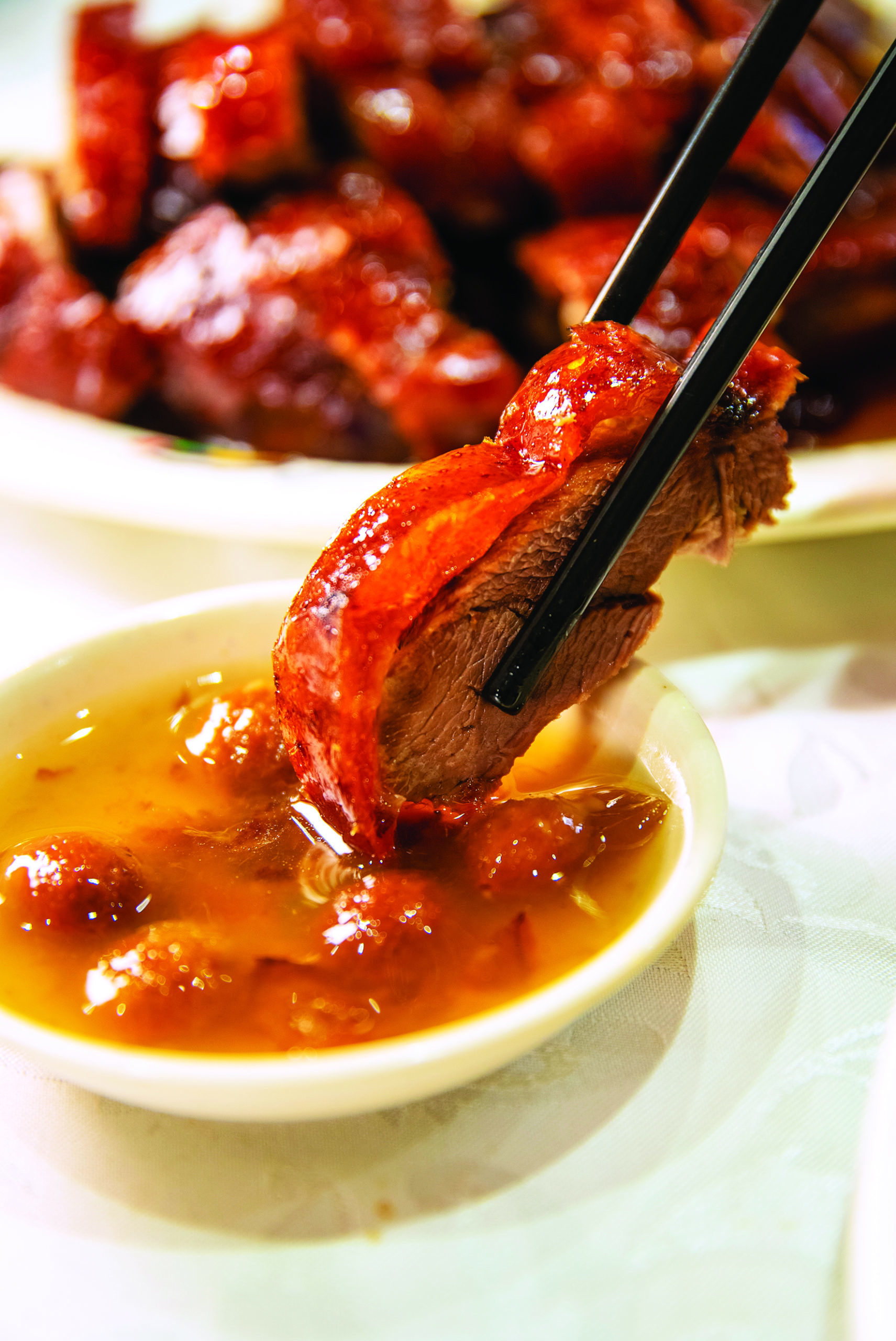
“Yue Kee ”
Michelin-starred Roast Goose
Visited by former Hong Kong Governors, and recognised by the Michelin Guide, “Yue Kee” is now a famous roast goose restaurant. During festivals or birthday gatherings, it is the number one go-to restaurant for many families. But when we talked to Sister Wah, the second generation owner of “Yue Kee” about the response of customers, she still displayed the enthusiasm of a new business owner. During our conversations, we complimented the roast goose and other dishes served at “Yue Kee”, and she was clearly very pleased: “I’m really happy to hear that the younger generation also appreciates our dishes,” she says with a smile.
Before roasting, the goose is marinated in salt, sugar, spices, spring onions and other ingredients. After that, it is hung to dry and coated with a sauce made with malt and vinegar. During the hour-long roasting, the ingredients stuffed inside the goose’s stomach come to the boil, adding flavours to the meat. A perfectly-roasted goose has a flawless surface, a puffy body and a crimson red colour. “The chef has to be very careful during the roasting, adjusting the heat and making sure the skin doesn’t crackle,” adds Sister Wah.
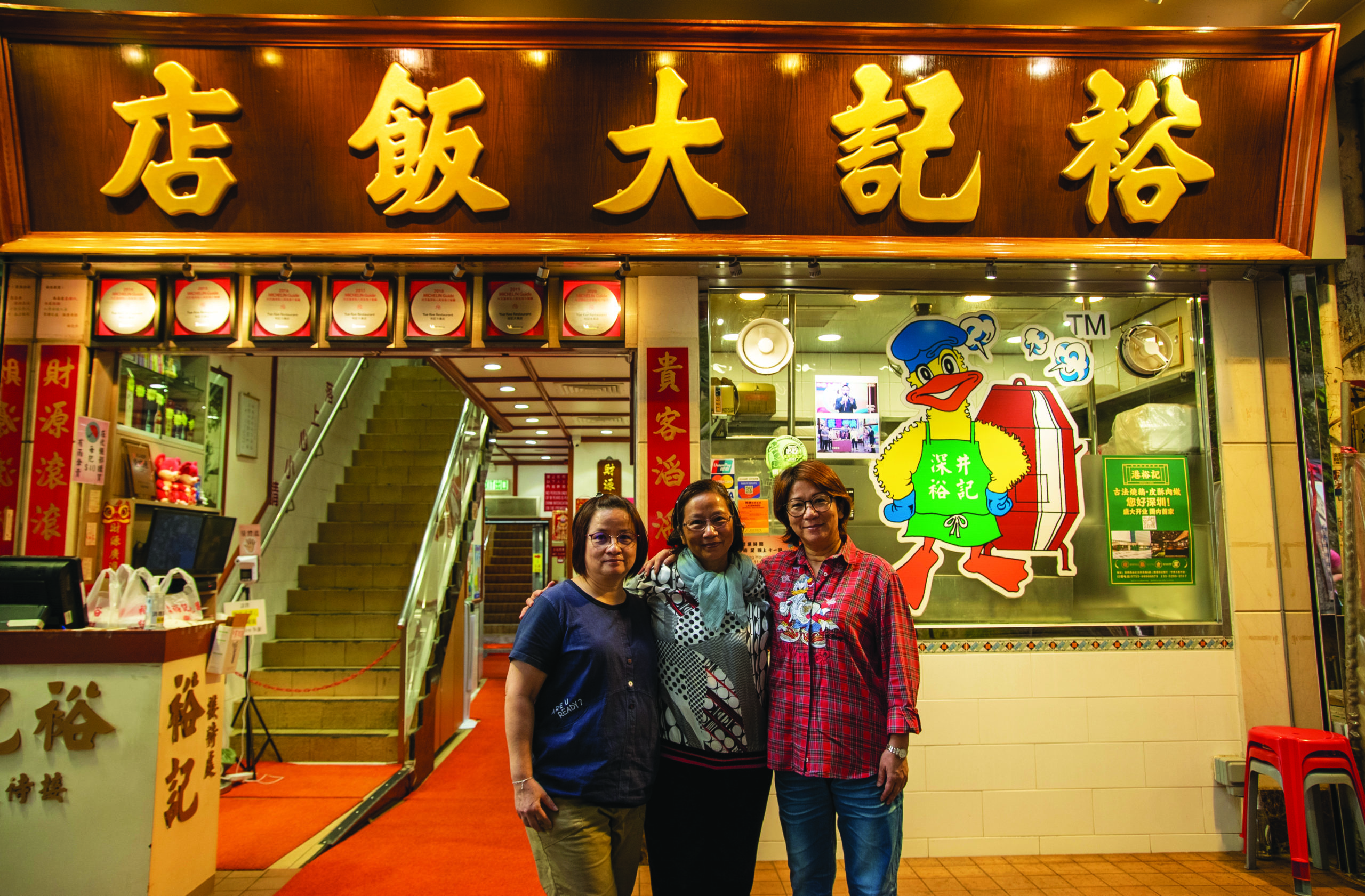
“The chef has to be very careful during the roasting, adjusting the heat and making sure the skin doesn’t crackle.”
“Yue Kee” sells freshly roasted goose straight from the grill, while customers wait. “The taste of ready-roasted goose cannot be compared with that of fresh ones – it’s totally incomparable!” Sister Wah declares proudly. But the difficulty lies in managing the expectations of customers, who may need to wait for some time. To advise its customers when the next batch of roast goose will be ready, “Yue Kee” makes regular announcements over a public address system. This has become a distinguishing feature of “Yue Kee”.
Every part of a “Yue Kee” roast goose is a culinary delight: the thighs are the most popular among Hong Kong customers, for their flavourful fats which melt instantly in one’s mouth. The breasts meanwhile have thicker meat, thinner skin and less fat, and are the best part for savouring the unique taste of goose. The back has little meat and thin skin, but absorbs all the flavours of the marinade. Finally, while the neck may not look very appealing, its meat is tender, and wrapped in fats that exude a lasting aroma.
Goose Thighs
Their flavourful fats melt instantly in one’s mouth
Goose Breasts
Have thicker meat, thinner skin and less fat, and are the best part for savouring the unique taste of goose
Goose Back
Has little meat and thin skin, but absorbs all the flavours of the marinade
Goose Neck
Its meat is tender, and wrapped in fats that exude a lasting aroma

Beginning as a street vendor
While most restaurants in town have switched to selling roast ducks to lower their costs, “Yue Kee” insists on selling roast goose. “My father put his soul into ‘Yue Kee’, so making compromises is simply unacceptable,” continues Sister Wah.
Indeed, the story of “Yue Kee Roast Goose” all began with its founder Ng Chun Yim (Ng), father of Sister Wah. In the 1950s, Ng moved to Hong Kong from Chaozhou on the mainland, and settled in Sham Tseng. At that time, Sham Tseng was still a small rural town with factories such as San Miguel Brewery and the Garden, surrounded by small villages where local communities grew vegetables and raised ducks. After serving as a chef at Kowloon Textile Industries, Ng opened a sidewalk booth with friends from Chaozhou, selling dishes such as “Braised Tofu with Peanuts”, and “Fish with Pickled Vegetables”. A few years later, he started his own family and noticed that Hong Kong people enjoyed eating roast duck – so he began selling rice with roast duck. In the backyard of his home, he raised ducks and roasted them over charcoal; this became a regular dining place for workers from the neighbouring factories – and the tradition of charcoal roasting remains to this day. Sister Wah herself has six siblings, and they have all helped out at the booth since they were young. “When I was still attending elementary school, I already knew how to slaughter a goose, remove its feathers and drain its blood.”

“Ng Chun Yim moved to Hong Kong from Chaozhou on the mainland, and settled in Sham Tseng. At that time, Sham Tseng was still a small rural town with factories.”
With the help of his wife, parents-in-law and wife’s brother, Ng laboured through the 50s and 60s, while the food of “Yue Kee” gradually became a signature product of Sham Tseng. As Hong Kong’s economy developed, “Yue Kee” was no longer visited just by workers from nearby factories, but also holidaymakers who drove into the countryside for the weekend. “At that time, the water quality at the beaches along Castle Peak Road was very good, and middle-class families liked to come here to enjoy roast duck rice or noodles after swimming.” Later on, the government cleared street vendors and granted land for “Yue Kee” to continue its business. In 1969, “Yue Kee” moved to its own shop for the first time and became a proper restaurant. “Yue Kee”’s reputation grew, and local factory owners would come and order roast ducks when they were entertaining guests.”
Interestingly, although “Yue Kee” has built its reputation on selling roast goose, it was roast ducks that it sold in its early years; and even Sister Wah admits roast duck is her first love. “To cut costs, duck breeders started using artificial feed, which made the taste deteriorate. My Dad was very serious about the quality of his merchandise, and goose cannot be raised with artificial feed. We wanted to keep up standards, so we decided to switch to selling roast goose. To ensure the quality of our geese, they are given only organic feed, rice and grain.”
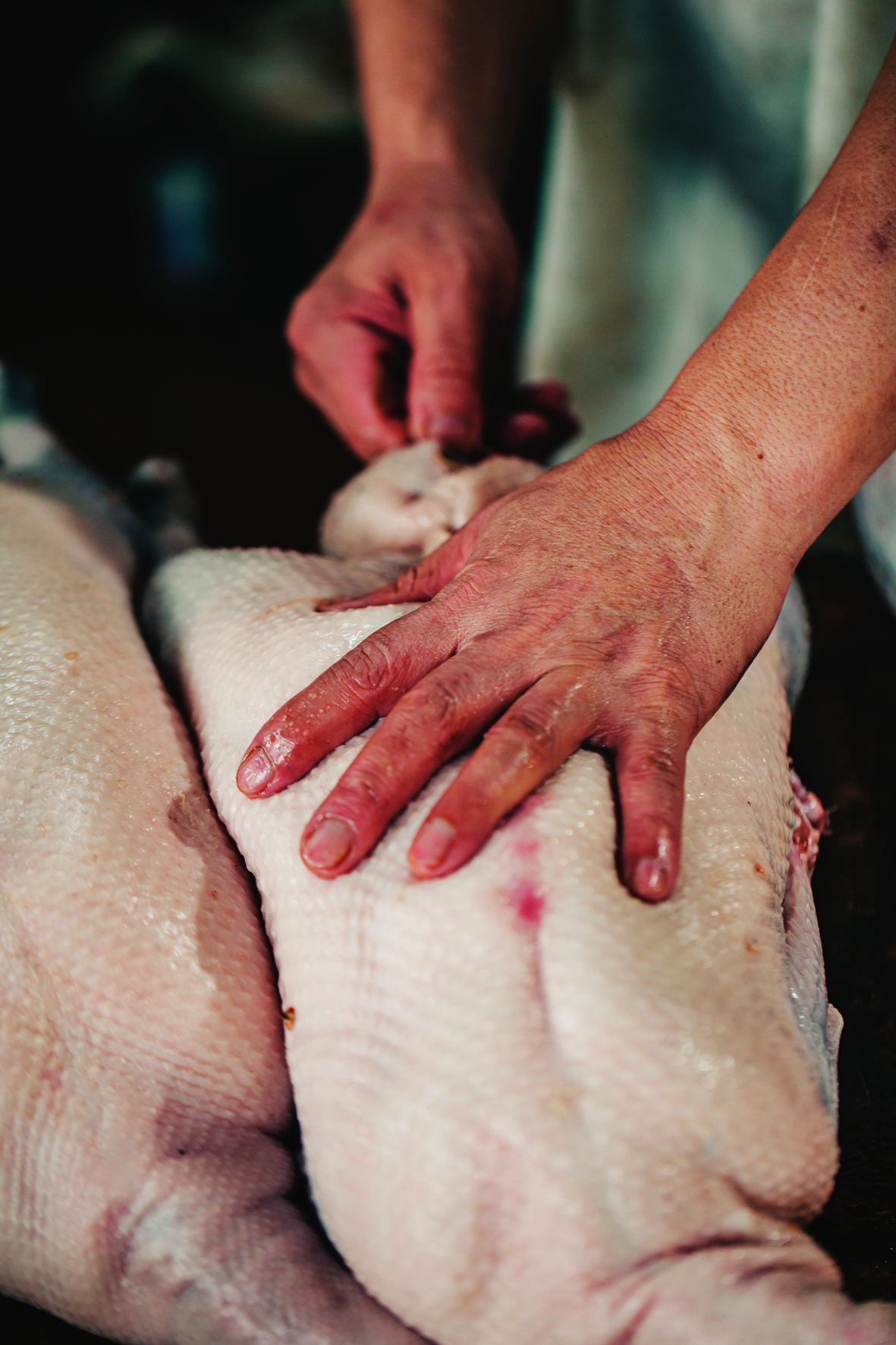
Stitching up the goose to seal the marinade
Hanging the geese to dry
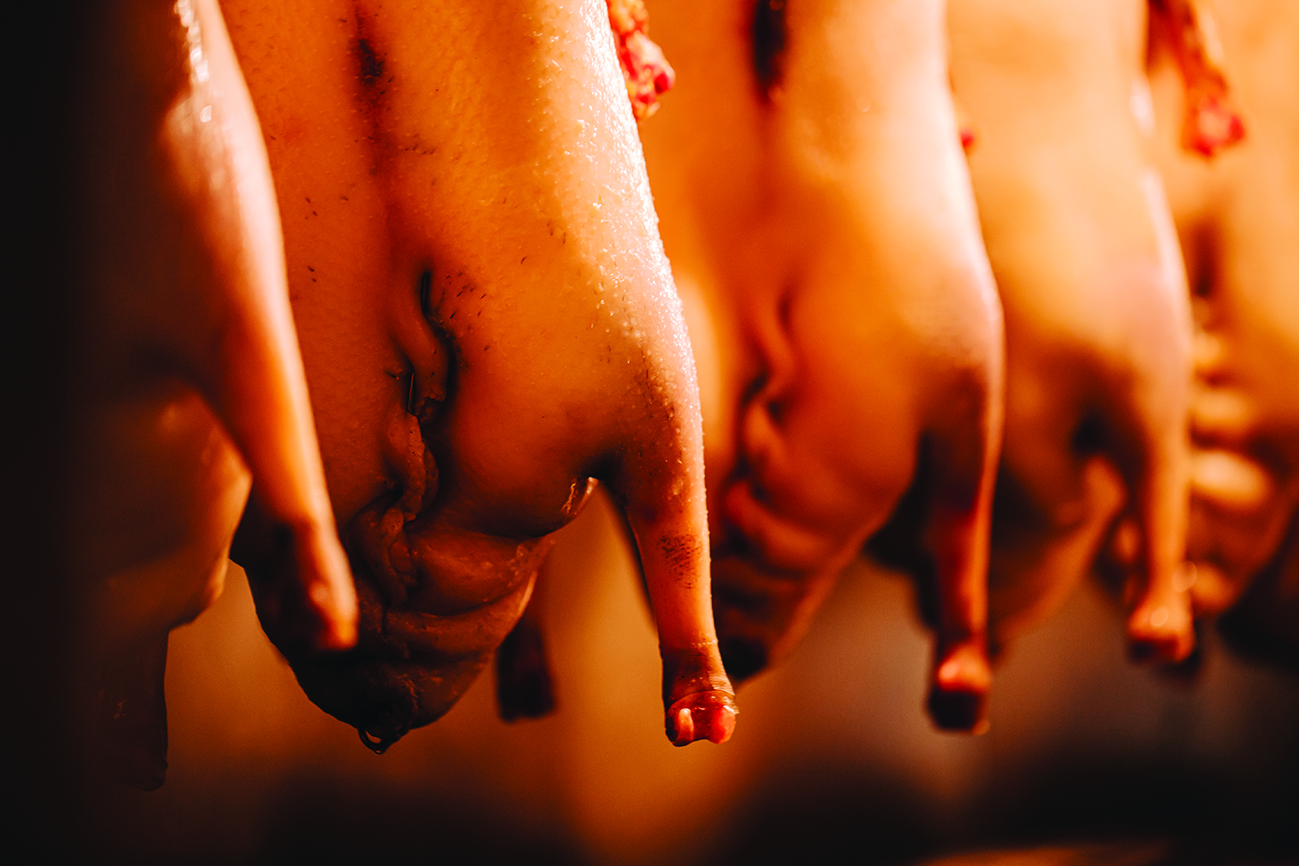
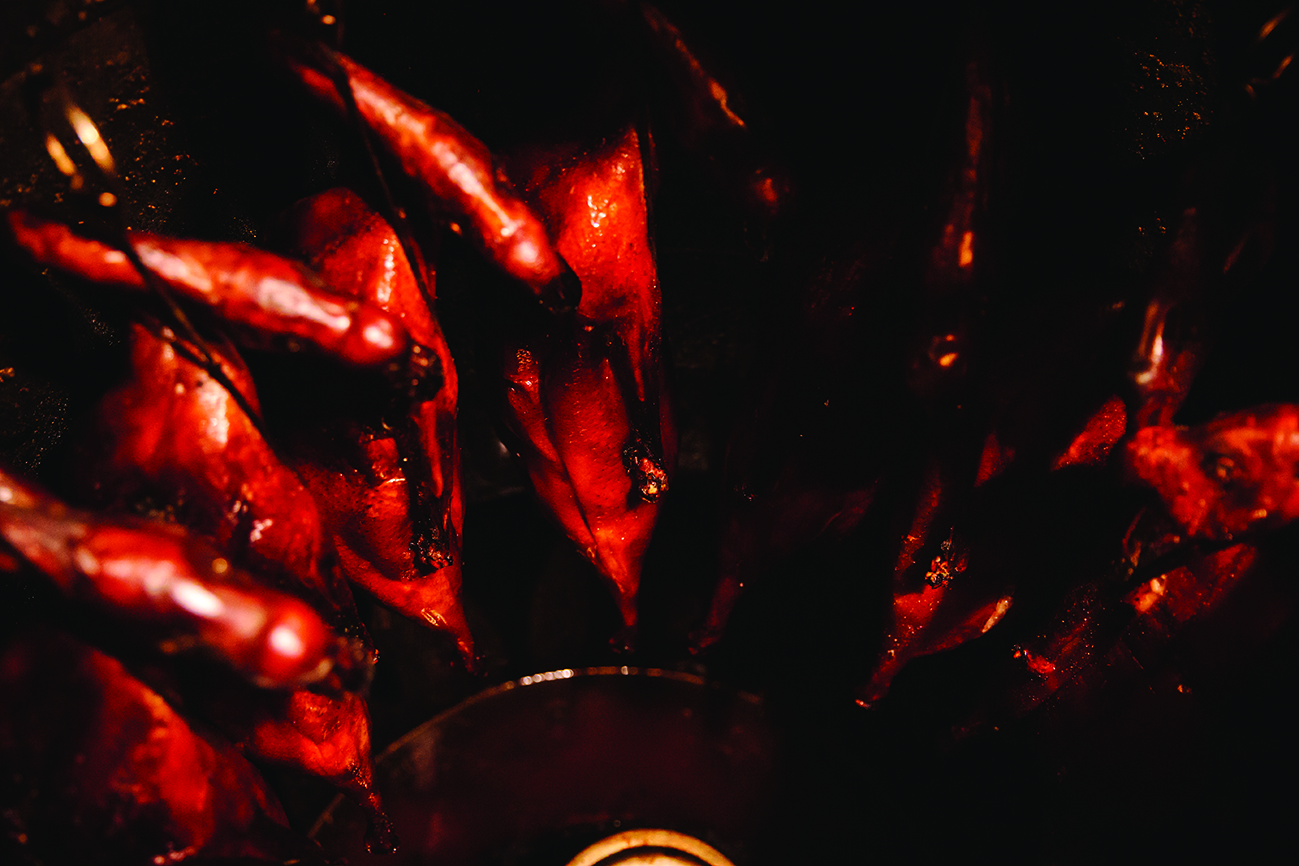
Roasting over charcoal
The perfect BBQ roast
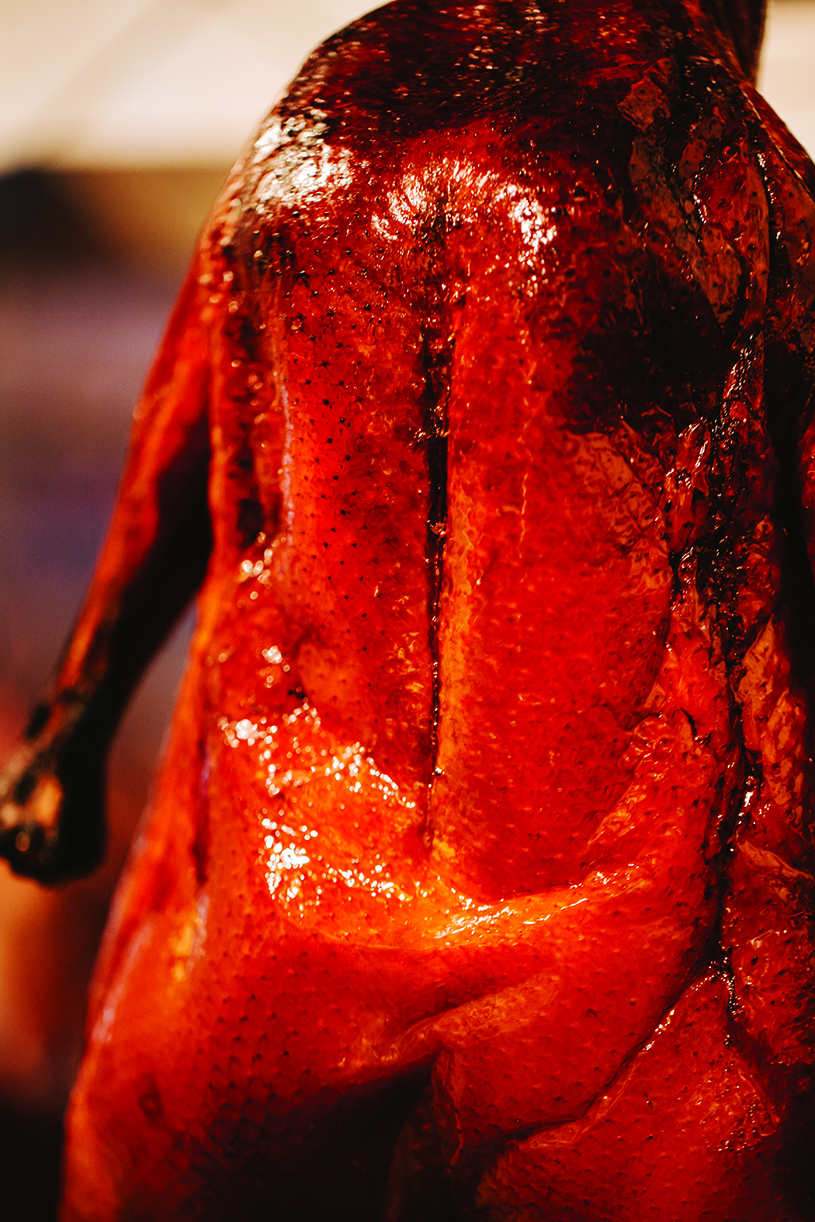
A goose expert by fate
Today, there is no longer a local supply of live geese, so “Yue Kee” sources its geese from farms in Qingyuan. But this doesn’t mean Sister Wah is making any compromises; when you speak to her about selecting geese, you come to realise this is a specialist skill in its own right. “We only take geese raised in huts. After raising the geese free-range for about half a year, we fatten them by keeping them in huts and feeding them grains. But building geese huts is costly, so many restaurants use free-range geese instead. These have less fat and are less tasty, so we don’t want them.” Buying high-quality “hut-raised” geese all the way from Qingyuan is no easy task: today, “Yue Kee” works with some 10 farms in Qingyuan, and has around 20 experts stationed there for sourcing geese. Despite the cost, Sister Wah insists on being the first to select from a new batch of geese. “As long as the quality is good, I take geese of all sizes.” During the pandemic, “Yue Kee” is offering discounts on all dishes, “but not for roast goose – the cost is too high, it’s just impossible.”
Sister Wah gained her knowledge not only from experience, but also through fate. In 1992, “Yue Kee” suffered a deadly fire in which her parents sadly lost their lives. “Yue Kee” reopened six months later. “It’s heart-wrenching to lose your parents, but we knew that they had poured their lives into ‘Yue Kee’, so our family made a promise to keep it alive.” Because of this, Sister Wah shouldered the responsibility of continuing the family-run business and started learning to source geese. Her uncle Lee Siu Hoi, who had formerly been a central figure in the restaurant, also helped lead the family through this crisis. Even today, Sister Wah still remembers vividly how nervous she was when she first took over her family’s business: “When I was young, I depended on my father, so I wasn’t very knowledgeable.” She visited Qingyuan once a week to monitor the quality of the farms; and to help her distinguish the geese from different farms, she would tie bands made of grass around their necks as identification.
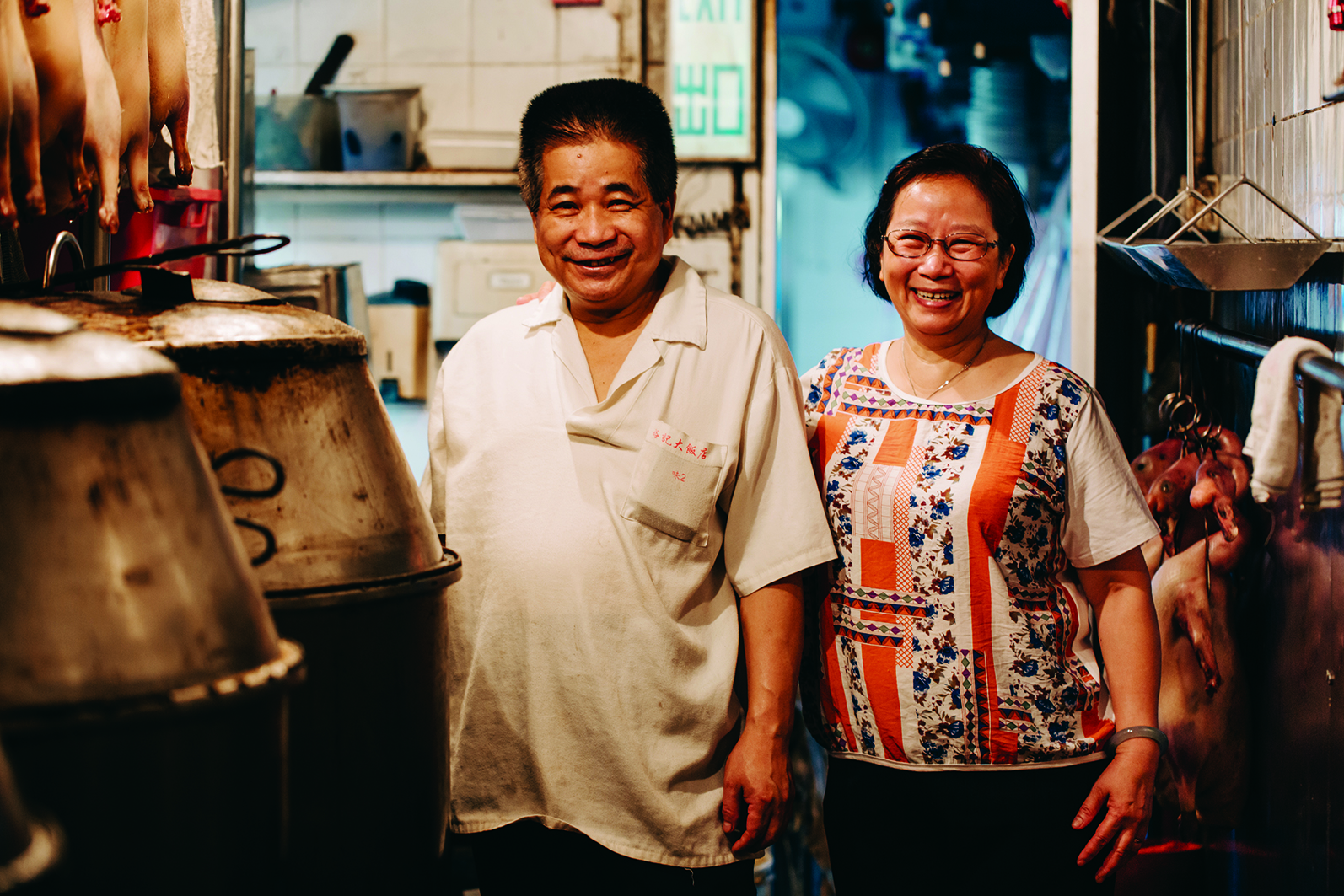
Sister Wah (right) with Liu Yung Hung (left), who has worked as Siu Mei chef for over 20 years.
“It’s heart-wrenching to lose your parents, but we knew that they had poured their lives into ‘Yue Kee’, so our family made a promise to keep it alive.”
Sister Wah’s persistence is not only reflected in the signature roast goose, but also other dishes by “Yue Kee”. “I once heard some tourists saying that ‘Yue Kee’ was only good for roast goose, and other dishes were not worth mentioning. This kept rankling in my mind.” So Sister Wah reviewed all her other dishes and made sure they tasted just as good: using fresh pork and beef, scallops from Australia, and making their own deep-fried stuffed crab claws instead of buying ready-made ones. As a result, customers today do not compliment “Yue Kee” only for its roast goose, but for its other dishes, too.
When you see Sister Wah managing this renowned restaurant with the same passion she displayed when running her family sidewalk booth back in the early days, you know that the success of “Yue Kee” is not merely a matter of luck.
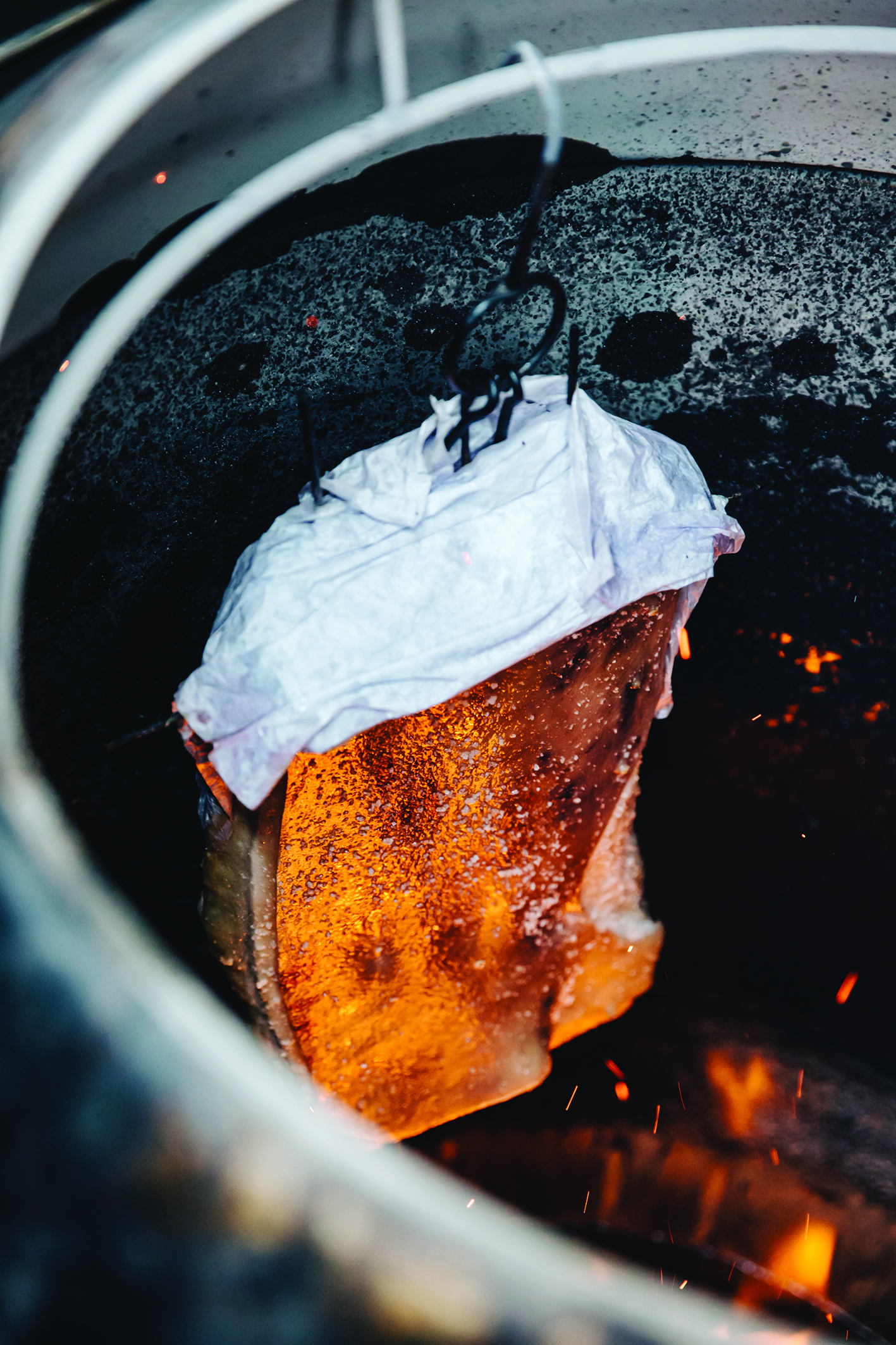
“Chan Luk Kee ”
Five-layered, Charcoal-roasted Pork Belly
“Chan Luk Kee” is an authentic, old-fashioned neighbourhood eatery in Hong Kong. Bearing witness to the passing of time, its walls have turned yellow, while its menu continues to hang there, listing its various famous dishes such as “Baked Fish Intestine with Egg” and “Pan-fried Stuffed Dace Fish on Hot Plate”. In the open kitchen next to the restaurant’s entrance, a chef is wielding a sharp butcher’s knife and chopping a large chunk of roasted pork belly into bite-size pieces. During the lunch-time peak, people from the neighbourhood and construction workers labouring nearby come to enjoy a satisfying meal — the signature “Five-layered Charcoal-roasted Pork Belly”, generally washed down with a bottle of ice-cold beer. The late founder Mr. Chan Yiu Sum was the sixth child in the family, and affectionately known as “Uncle Six” (or “Luk Kee” in Cantonese): so the restaurant is simply called “Chan Luk Kee”. Today, this long-established restaurant with more than half a century of history is being kept alive by his son Chan Kwai Hei (Chan), and it remains as popular as ever.
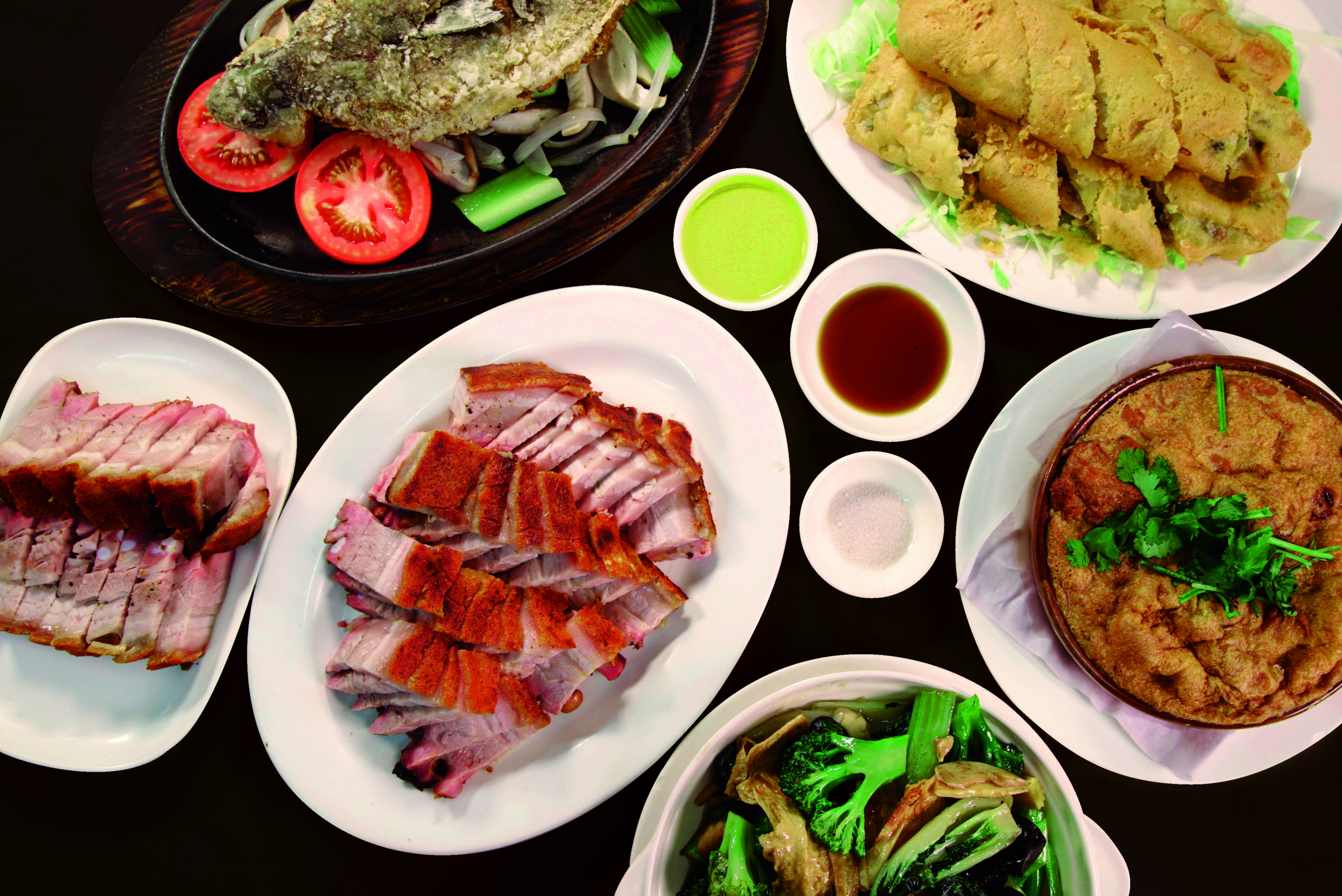
“The second and sixteenth days of the lunar month were our busiest days, when people bought food and made sacrifices to the God of Wealth and merit, in a tradition known as ‘zuoma’ (做禡). ”
Affordable festive delicacies
Today, Hong Kong people still buy roast pork belly as a spiritual offering to celebrate festivals, and the “Five-layered, Charcoal-roasted Pork Belly” of “Chan Luk Kee” is the first choice for many living nearby, and outside the local area.
The restaurant is located on Tsun Fu Street in Shek Wu Hui, Sheung Shui; “Shek Wu Hui” used to be an old-style market, while the name of the street commemorates two officials from the Qing Dynasty, famed for their kindness to their people. “In the past, Shek Wu Hui was a busy market where people would set off firecrackers during celebrations. It was very lively!” recalls Chan Kwai Hei. Today, Chan is approaching his seventies, but his colourful childhood memories of Shek Wu Hui are still vivid.

Chan Kwai Hei – the second generation owner of "Chan Luk Kee".
In the old days, many traditional shops such as rice stalls, mahjong parlours and traditional goldsmiths formed the heart of the district. “The second and sixteenth days of the lunar month were our busiest days, when people bought food and made sacrifices to the God of Wealth and merit, in a tradition known as ‘zuoma’ (做禡). We had more business on these days than even during Chinese New Year and the Winter Solstice.” “Zuoma” are important days for businesses, when old-style shops in Hong Kong usually give free meals to their staff, who would gather to enjoy the wholesome food. Although the Sheung Shui community has changed tremendously over recent decades, with many traditional shops replaced by pharmacies (mainly serving tourists from the Mainland), Chan still follows the old practices: “At ‘Chan Luk Kee’, we still use roast pork belly to worship the God of War and the Earth God of Wealth and Merit twice a month,” Chan says with a smile.
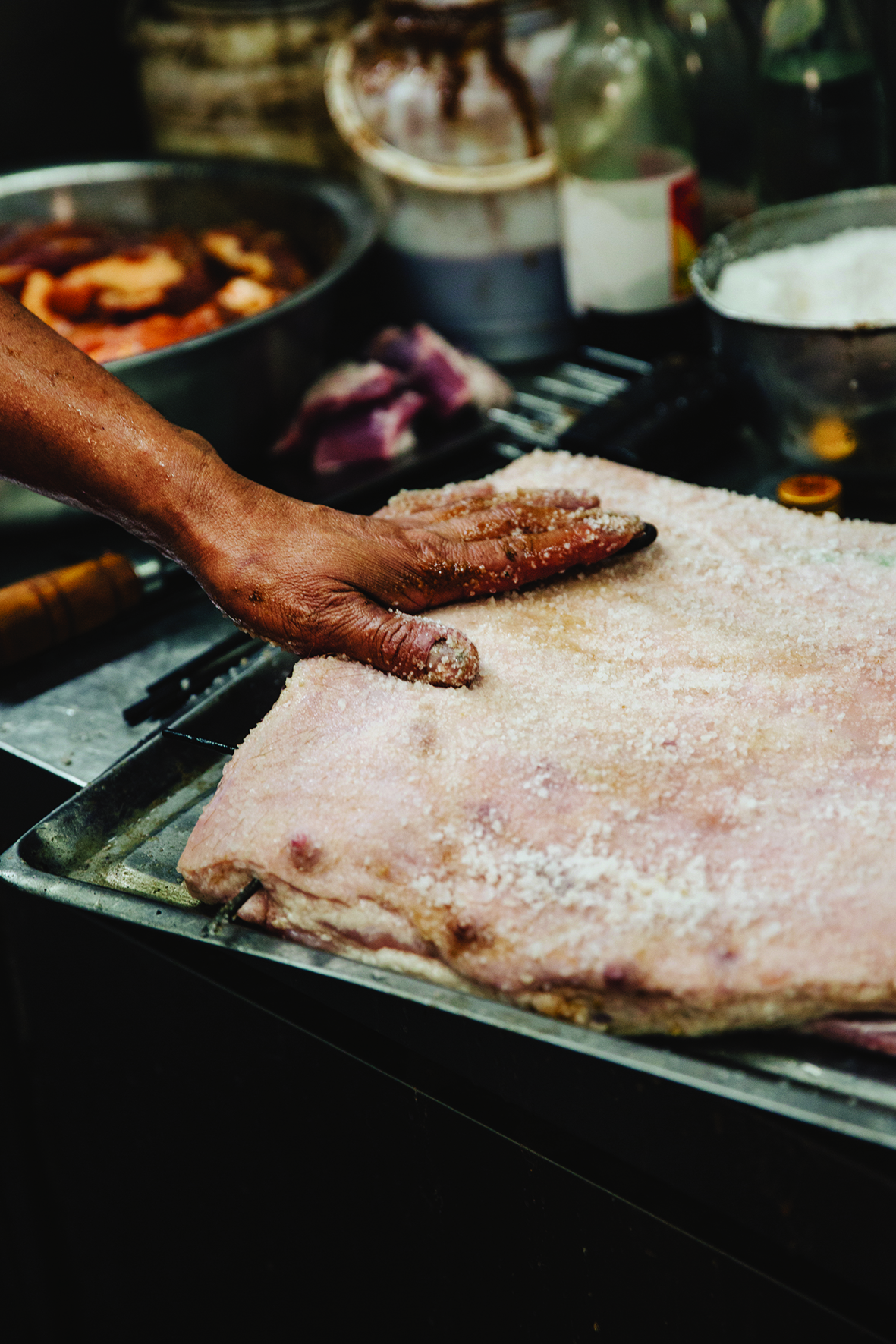
Marinading
Pricking small holes allows the spices to soak in

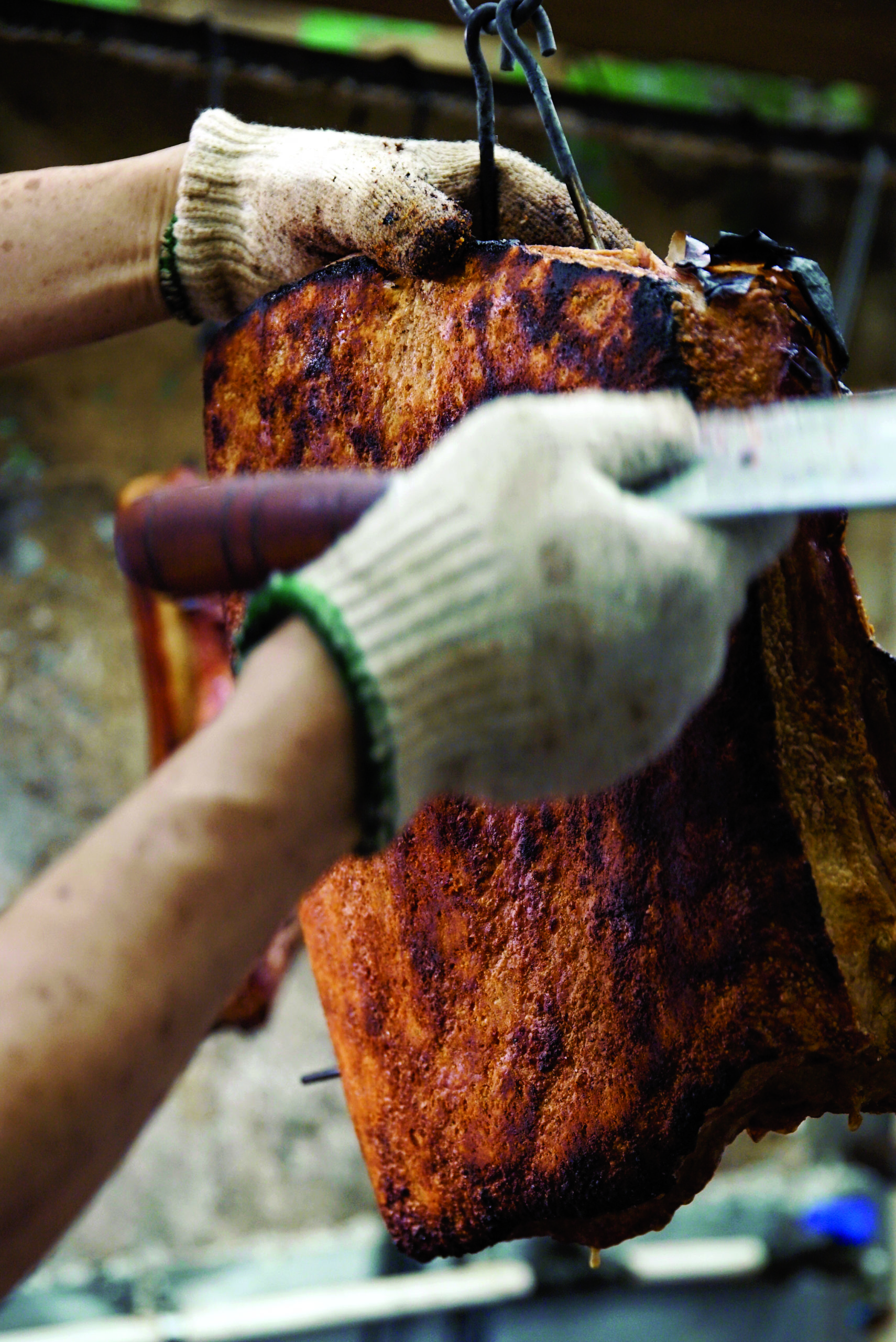
Removing charred skin & bristles
Ready to serve
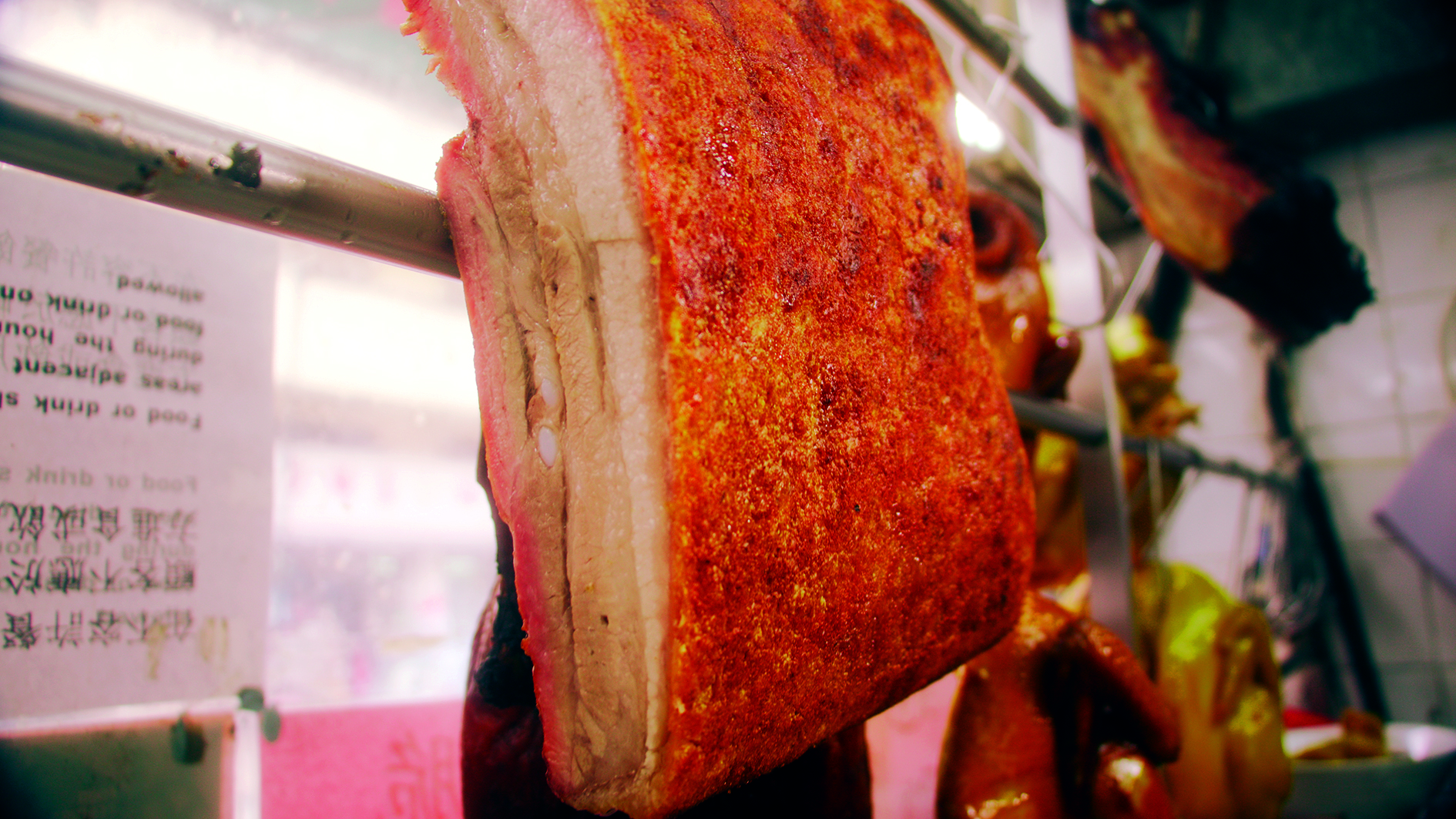
Secret of the “Five-layered, Charcoal-roasted Pork Belly”
As with “Yue Kee”, “Chan Luk Kee” is one of very few traditional restaurants in Hong Kong still allowed to cook with a charcoal stove. Pork belly roasted with charcoal from Indonesia is incomparable, and its taste cannot be matched by restaurants using modern cooking methods. When you take a bite of the pork belly, you can hear the loud crackling of the skin. Beneath the crunchy, dark red “sesame skin” is a layer of fat, followed by a layer of lean and savoury meat, a piece of chewy cartilage, then a layer of tender meat which provides a memorable taste. Naming this roast pork belly “five-layered” is not just a gimmick: it truly contains five layers of pork, each with a distinctive texture. After years of rigorous training by his father, Chan now picks only the best quality pork belly, and even sets a standard for the meat-to-fat ratio: “The ideal ratio is one-third fat to two-thirds lean meat. Excessive fat makes it greasy, while too much lean meat makes it dry and chewy,” Chan explains.
Before putting the pork belly into the charcoal stove, the flesh side is marinated overnight in a sauce consisting of coriander, shallots, thirteen spices powder, sesame sauce and other spices — while the rind is generously sprinkled with cooking salt. The roasting takes place in three stages: the first roast softens the thick and firm skin, after which the chef pricks small holes in the skin and rubs extra cooking salt all over. During the second round, the rind crisps up, forming a nice crackling; the rind is now a little charred, as the strongest heat is applied during this stage. The chef scrapes away this charred skin and any bristles. In the final round, a coating of lard is applied to the pork belly; when this drips onto the fire, the meat is showered in sparks, and the skin is roasted to a delicious golden colour. Now, finally, the “Five-layered, Charcoal-roasted Pork Belly” is ready to be served.
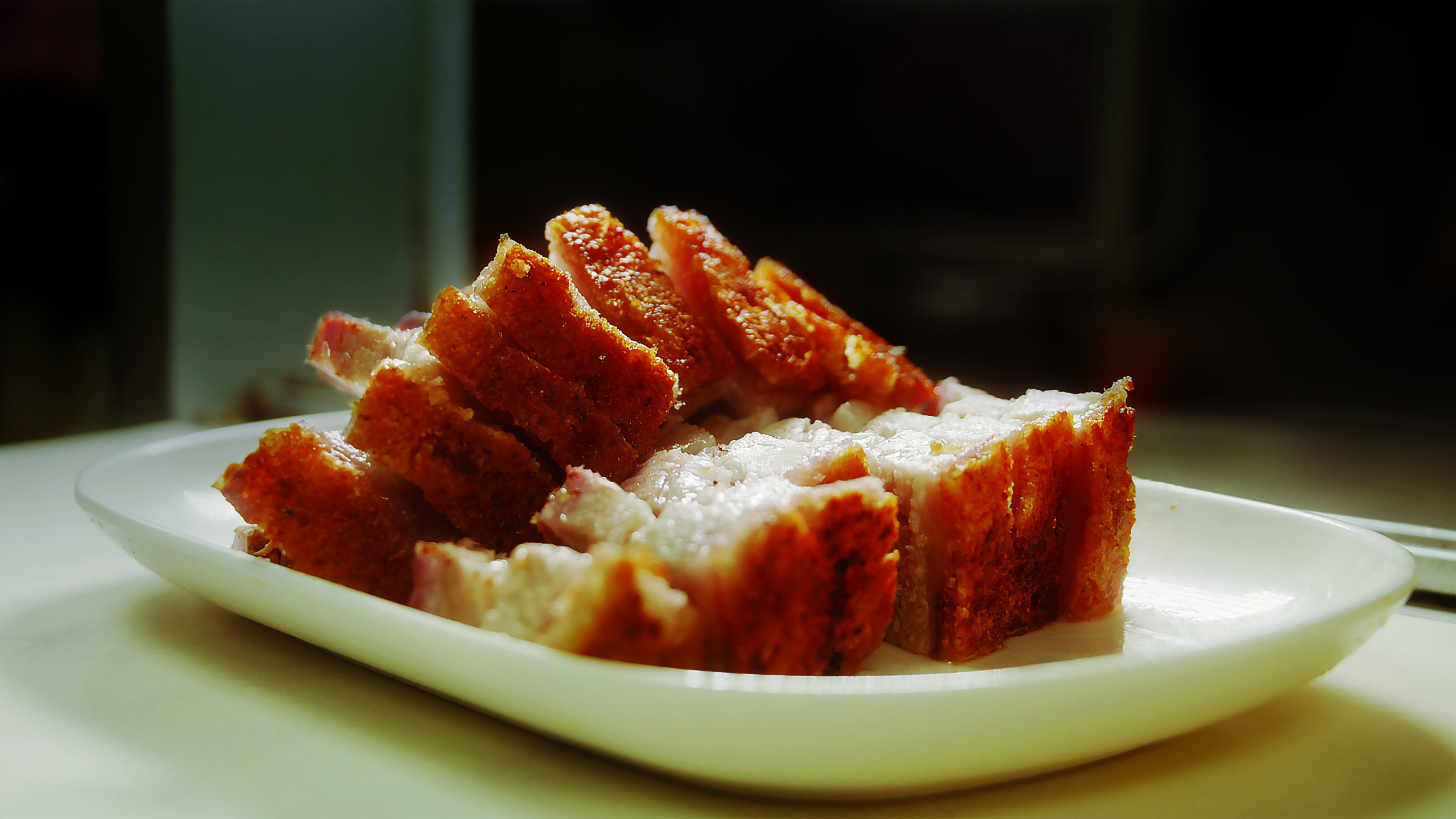
“The ideal ratio is one-third fat to two-thirds lean meat. Excessive fat makes it greasy, while too much lean meat makes it dry and chewy.”
The Chan family dining room
Chan’s father, Uncle Six, was born in Shunde. He fled his hometown and came to live in Hong Kong in the 1950s. He took many different jobs: including hawker, and as a chef at the Police Station in Sha Tau Kok. Says Chan: “My Dad loved cooking and put a lot of effort into it in his spare time. Maybe that's why he finally chose a career in cooking.” In the early 60s, Uncle Six opened a food stall with a few hometown friends, selling porridge and Shunde cuisine. In 1967, he established “Chan Luk Kee” at its current location. Uncle Six had learned the knack of roasting pork belly under the guidance of a chef friend. He made great efforts to improve the technique, with the result that the name of “Chan Luk Kee” has been gaining in stature ever since the 1970s.
For as long as Chan can remember, he helped out in the restaurant. “When I was little, I helped chop ribs and even tried accidentally cutting myself! Then when I grew older, I learned to roast meat in the kitchen. My Dad was an earnest person. If you didn’t follow his instructions properly, you would definitely be chewed off; that applied to his children as well!” Uncle Six is indeed a legend in Sheung Shui - he still helped out in the restaurant until he was nearly 90 years old. Although Uncle Six was a strict father, Chan clearly still respects him very much.
Chan Kwai Hei (right) with Ho Yuk Wan (left), who has worked for “Chan Luk Kee” as Siu Mei chef for over 30 years.
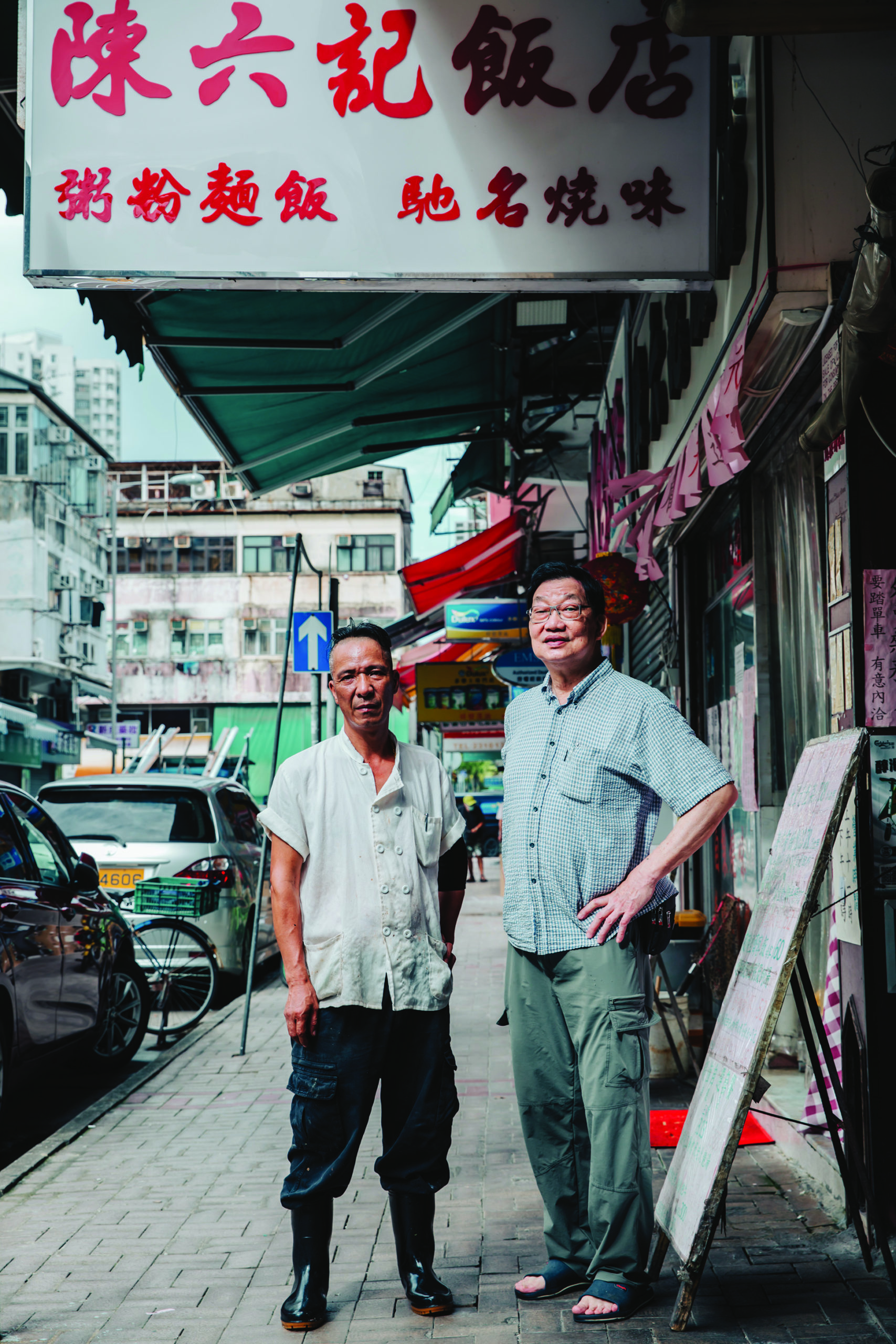
Chan is the eldest of ten children, and recalls how most of the positions in the restaurant including waiters, cashiers and chefs were held by his siblings or his sisters-in-law. Today, Chan's wife, his elder sister and younger sister still work in the restaurant.
Chan himself worked as a civil servant for many years: "I worked in six or seven government departments, such as Mobile Libraries, Agriculture, Fisheries and Conservation Department, and Food and Environmental Hygiene Department.” No matter where he worked, Chan never moved out of Sheung Shui and continues to live there with his family. Even after a hard day’s work, he always came home to help out enthusiastically in the restaurant. “I was very happy. We chatted and laughed in the restaurant. I did not feel tired helping out after work and did not regard it as a burden. The most memorable thing was celebrating our parents’ birthdays, babies’ first month birthdays and various festivals in our own restaurant. ‘Chan Luk Kee’ is the Chan family dining room!”
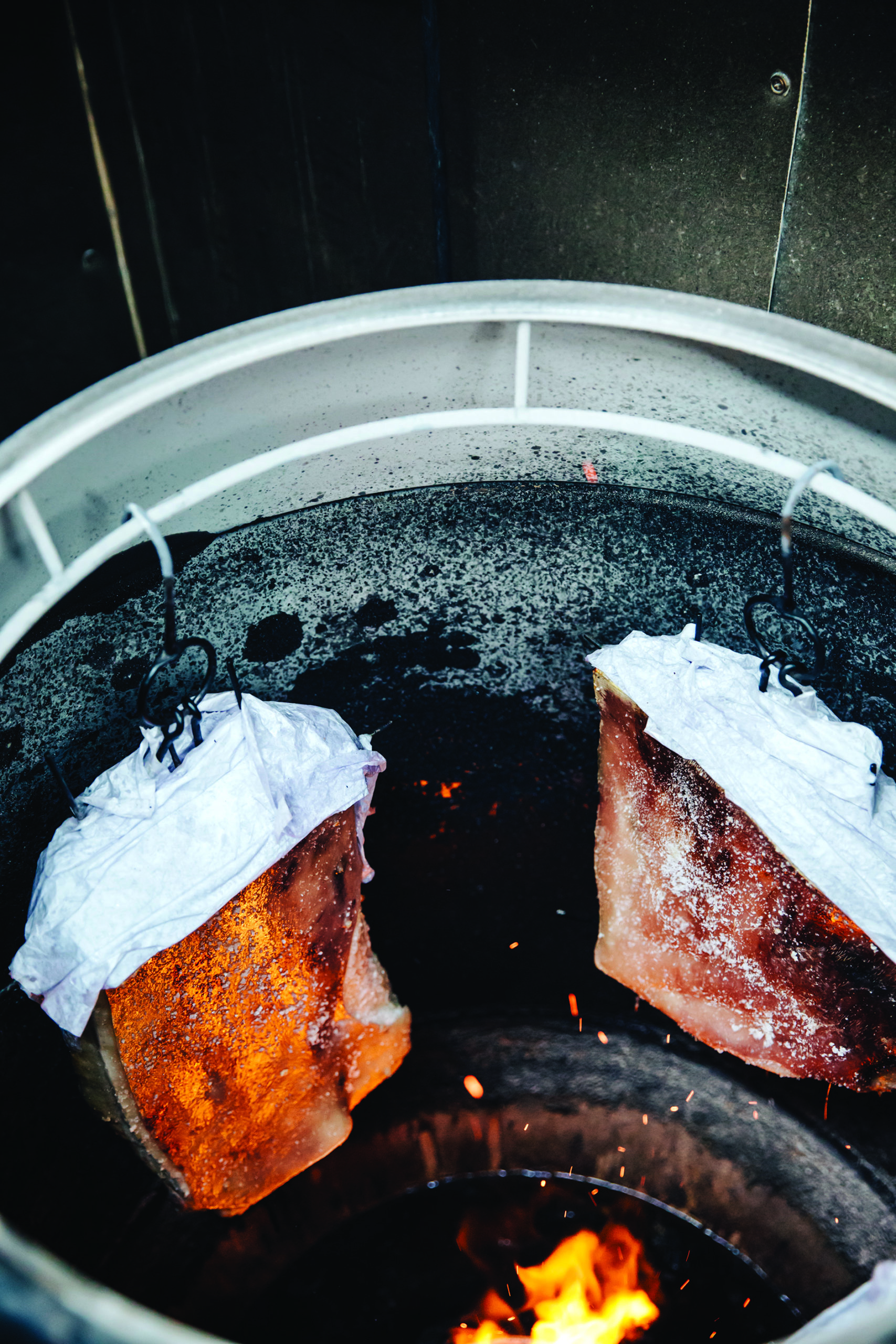
“There is no one in the third generation willing to take it over. But, as long as I’m still able to work, I will keep running it.”
Unexpected successor
When Chan was young, he could hardly sit still and always wanted to explore. Although he loved staying in the restaurant after work, he never thought about taking over “Chan Luk Kee” – until, that is, the 70-year-old Uncle Six decided to step back in 1992. The ten siblings discussed the future of “Chan Luk Kee”, and even persuaded their father to sell the business. However, Chan knew that his father had given half his life to “Chan Luk Kee”, and was extremely reluctant to hand it over to an outsider. Finally, Chan gritted his teeth and promised to take over “Chan Luk Kee”—and the restaurant continues under his ownership to this day.
Since Chan took over, not only has the signature “Five-layered, Charcoal-roasted Pork Belly” maintained its quality: it’s joined by other traditional dishes not commonly seen in Hong Kong, such as “Baked Fish Intestine with Egg”. Fish intestines are rejected by most modern restaurants because the dish requires great effort, but earns little. But the baked fish intestine served by “Chan Luk Kee” — a mixture of egg and fried dough stick — is definitely a long-lost, old-style delicacy. Another traditional Shunde dish is “Pan-fried Stuffed Dace Fish on Hot Plate”; to make this more appealing, Chan decided to serve it on a hot plate and pour sauce over it in front of guests, creating a colourful, aromatic and mouth-watering dish.
Although “Chan Luk Kee” is always crowded with food lovers, now that Chan is himself approaching retirement age, the succession problem has arisen once again. “There is no one in the third generation willing to take it over. But, as long as I’m still able to work, I will keep running it,” Chan says with a smile. He may not know what the future holds, but he does know he’s not going to let all his father’s hard work go to waste.

